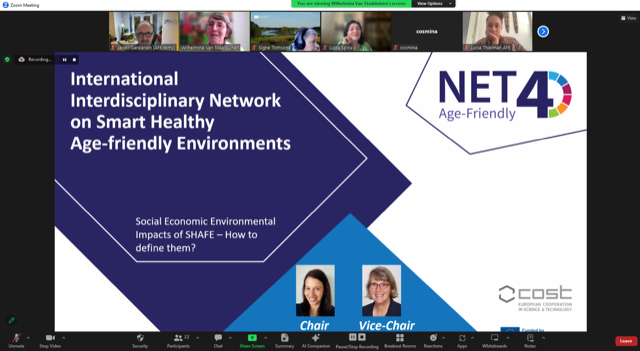
On October 17th, 2023, NET4Age organised a webinar on how to assess the impacts of Smart Healthy Age-Friendly Environments (SHAFE). Which social, economic and environmental impacts can be identified and defined about SHAFE measures? How can you perform an ex-ante evaluation to make policy decisions and involve multiple stakeholders?
Vice-chair and grant holder of NET4Age, Willeke van Staalduinen, presented to about 30 participants the process of impact assessment on SHAFE. She presented the SHAFE SEE-IT. This impact tool is based on the SEE-IT, developed in 2014-15 by Rodd Bond, Mireia Ferri and herself in the frame of AFE-INNOVNET.
The SHAFE SEE-IT considers smart healthy inclusive environments for citizens of all ages. The geographical level can be everywhere: in communities, regions or nations. SHAFE SEE-IT can be performed as an ex-ante and as an ex-post evaluation when initiatives, programmes, policies or projects are going to be developed or are ending.
The impact assessment goes through the cycle of the following phases: AIM, SCOPE, ASSESSMENT, ANALYSIS and RESULTS. The process starts with bringing together the assessment team consisting of multiple stakeholders with diverse backgrounds. The team identifies out of the lists of social, economic and environmental impacts, which impacts are relevant for the initiative, programme, policies or projects. Social impacts can address, for example, the quality of social interaction, basic rights or health and longevity. Economic impacts can include standard of living, public budgets, consumption and production. The final angle is the potential environmental impacts: land use, housing, resources/waste.
From each chosen impact, the team defines the direction (negative, neutral, positive), the intensity (neutral, weak, strong) and who is directly or indirectly impacted. The team can also monetise or quantify the impacts. For example, by looking at the scale and significance, link to market prices, costs, Quality Adjusted Life Years or Healthy Life Years or Costs of Illness. Data can be retrieved from local, regional or national governmental or scientific resources, and from databases such as Eurostat.
Based on the assessment, the team performs the analysis and defines the results to present to policymakers or to take a decision on the following steps.
After the presentation, the participants split into breakout rooms to work on an impact assessment themselves. They evaluated a few measures that could be taken to improve a neighbourhood in Europe where the houses are not equipped for an ageing population, the number of people with overweight heavily increases and many people feel lonely or isolated. The groups presented their results to the plenary at the end of the webinar.
The overall takeaway message from the impact assessment by SHAFE SEE-IT is that these evaluations give direction to decisions, and above all, that jointly assessing potential impacts is positive for creating support for decisions.